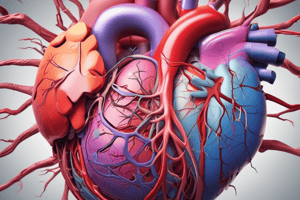Podcast
Questions and Answers
What is the correct sequence of events in one cardiac cycle?
What is the correct sequence of events in one cardiac cycle?
- Isovolumic contraction, Ventricular filling, Diastole
- Isovolumic relaxation, Atrial systole, Ejection
- Atrial systole, Isovolumic contraction, Ejection (correct)
- Atrial systole, Ejection, Isovolumic relaxation
Which artery is NOT a branch of the left coronary artery?
Which artery is NOT a branch of the left coronary artery?
- Left anterior descending artery
- Both A and B
- Right marginal branch (correct)
- Circumflex artery
In the context of the cardiovascular system, which formula correctly describes flow?
In the context of the cardiovascular system, which formula correctly describes flow?
- Flow (I) = P × R
- Flow (I) = R × P
- Flow (I) = P / R (correct)
- Flow (I) = R / P
Which phase of the cardiac cycle follows isovolumic contraction?
Which phase of the cardiac cycle follows isovolumic contraction?
What is the relationship between resistance and the radius of a vessel?
What is the relationship between resistance and the radius of a vessel?
What is the relationship between blood pressure, cardiac output, and peripheral vascular resistance?
What is the relationship between blood pressure, cardiac output, and peripheral vascular resistance?
Which hormone is primarily secreted when the atrium or ventricle is stretched due to increased blood volume?
Which hormone is primarily secreted when the atrium or ventricle is stretched due to increased blood volume?
Which condition is primarily characterized by low cardiac output and decreased ejection fraction?
Which condition is primarily characterized by low cardiac output and decreased ejection fraction?
How does angiotensin II affect blood pressure?
How does angiotensin II affect blood pressure?
What is true about diastolic dysfunction?
What is true about diastolic dysfunction?
Which of the following triggers the secretion of renin?
Which of the following triggers the secretion of renin?
What is the main physiological change associated with increased afterload?
What is the main physiological change associated with increased afterload?
Which of the following factors does NOT typically lead to cardiovascular disease?
Which of the following factors does NOT typically lead to cardiovascular disease?
What is the effect of sympathetic activity on heart parameters?
What is the effect of sympathetic activity on heart parameters?
How does aldosterone influence renal function?
How does aldosterone influence renal function?
Flashcards are hidden until you start studying
Study Notes
Cardiac Anatomy
- Heart consists of multi-chambers and functions as a dual cycle electrical pump.
- Key coronary vessels:
- Right coronary artery includes conus, right marginal branch, and posterior descending branch.
- Left coronary artery comprises the left anterior descending and circumflex arteries.
- Coronary capillaries facilitate nutrient exchange.
- Coronary veins include the coronary sinus, great cardiac vein, and posterior vein of the left ventricle.
Cardiac Cycle
- Represents the sequence of events in one heartbeat, including:
- Diastole: heart relaxation phase.
- Systole: heart contraction phase.
- Phases of cardiac cycle:
- Atrial systole,
- Isovolumic contraction,
- Ejection,
- Isovolumic relaxation,
- Ventricular filling.
Electrical Circuit and Ion Concentrations
- Sodium and potassium ion concentrations are crucial:
- Sodium [Na+] = 140 mEq/L, [Na+] inside cell = 10 mEq/L.
- Potassium [K+] = 4.0 mEq/L, [K+] inside cell = 120 mEq/L.
- Electrochemical gradients contribute to action potential generation.
Excitation-Contraction Coupling
- Excitation-contraction coupling involves steps leading to muscle contraction in cardiomyocytes, the heart's muscle cells.
Cardiac Output and Regulation
- Cardiac output (CO) calculated as CO = Stroke Volume (SV) x Heart Rate (HR), measured in liters/minute.
- Factors influencing blood pressure include cardiac output (BP = CO x Peripheral Vascular Resistance).
- Resistance in the cardiovascular system is determined by the formula:
- Resistance = 8ηL / πr^4, with r being the radius, L as the length, and η denoting viscosity.
Blood Pressure Regulation
- Normal blood pressure is regulated by monitoring cardiac output and peripheral vascular resistance.
- Sympathetic activity boosts heart rate and contractility while promoting vasoconstriction.
- Hormonal influences from substances like epinephrine and natriuretic peptides also modulate blood pressure.
Heart Failure
- Types of heart failure include:
- Systolic dysfunction characterized by low cardiac output and decreased ejection fraction.
- Diastolic dysfunction with preserved ejection fraction but increased left ventricular end-diastolic pressure (LVEDP).
- Common etiologies encompass hypertension, ischemic injury, valvular disease, genetic factors, and myocarditis (viral or autoimmune).
Atherosclerosis and Coronary Artery Disease (CAD)
- Atherosclerosis is a specific form of arteriosclerosis, defined by:
- Thickening and hardening of arterial walls due to lipid-laden macrophages.
- Involves plaque development through inflammation, cellular proliferation, and oxidized LDL formation.
- Coronary artery disease refers to vascular disorders narrowing or occluding coronary arteries, typically stemming from atherosclerosis.
- Risk factors for CAD include dyslipidemia, hypertension, smoking, diabetes, obesity/sedentary lifestyle, and chronic kidney disease.
Myocardial Remodeling and Baroreceptor Activity
- Myocardial remodeling can manifest as hypertrophy, atrophy, or apoptosis due to nutrient/oxygen delivery fluctuations.
- Baroreceptors respond to changes in blood flow and pressure, leading to adjustments in renal sympathetic activity and sodium retention.
Integrated Function
- The relationship between flow (I), pressure (P), and resistance (R) encapsulates cardiovascular dynamics, emphasizing the importance of these elements in maintaining physiological homeostasis.
Studying That Suits You
Use AI to generate personalized quizzes and flashcards to suit your learning preferences.




